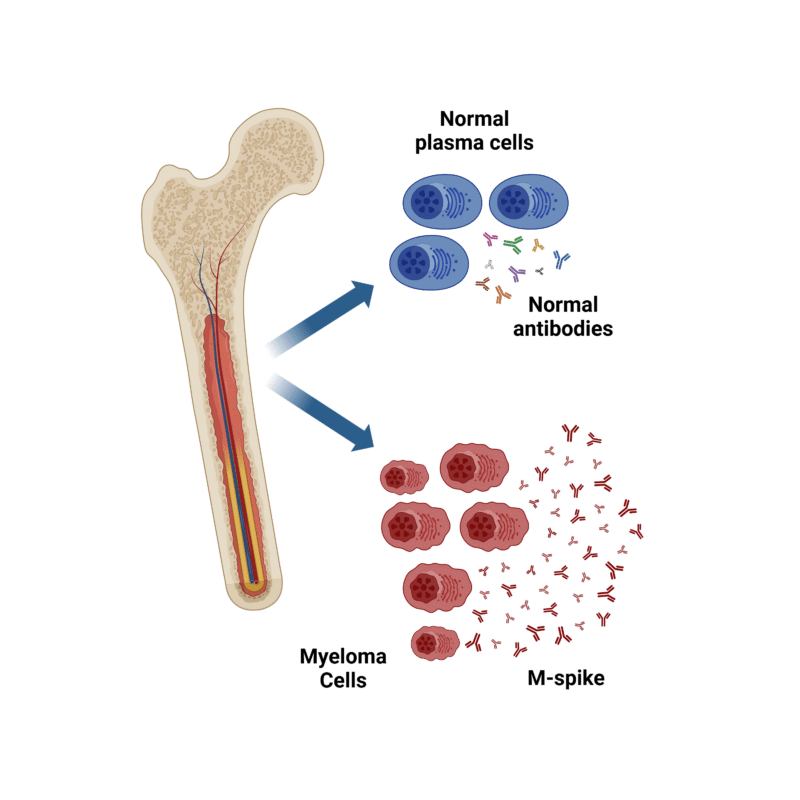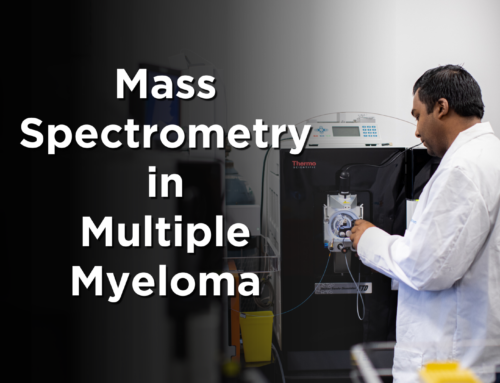Introduction
In this article, we revisit the M-spike protein and its importance as a biomarker in multiple myeloma.
The introduction and use of novel and powerful treatment options have significantly improved the outcomes for multiple myeloma patients. With response rates close to 100%, clinicians are looking for better tools for monitoring minimal residual disease (MRD).1,2
New blood tests like EasyM™ provide a promising and non-invasive way to monitor disease. Unlike traditional MRD tests, they do not require samples from invasive bone marrow aspirate. These highly-sensitive tests use mass spectrometry to check for residual disease in the blood by monitoring M-spike at low concentrations.
Multiple Myeloma and M-Spike
In healthy people, plasma cells in the bone marrow make many types of immune proteins, called antibodies. They help to protect the body from infections and diseases.
In patients with multiple myeloma (MM), a type of plasma cell disorder, some plasma cells become abnormal and begin to grow uncontrollably. The buildup of myeloma cells causes overproduction of identical antibody proteins in the blood. These are known as para-protein, monoclonal proteins, M-proteins, or M-spike (Figure 1).3
M-spike proteins made by myeloma cells consist of two main components, the heavy and light chains (Figure 2). Different types of MM consist of various combinations of heavy and light chains. Some types of MM only have light chains while others do not produce any M-spike at all (non-secretory myeloma). You can see these combinations in Table 1. Doctors will use blood tests like immunofixation electrophoresis (IFE) to determine the patient’s specific subtype by measuring the amounts of the different components in the blood.
Figure 1. M-spike proteins produced by cancerous abnormal plasma cells in the bone marrow. In healthy patients, normal plasma cells produce normal and distinct polyclonal antibody populations used to fight infections and disease.
Figure 2. The structure of an M-spike monoclonal immunoglobulin.
Table 1. Different myeloma subtypes.
M-Spike as a Biomarker in Multiple Myeloma
The significance of M-spike proteins lies in their usefulness as a biomarker for multiple myeloma.4 In most cases, high levels of M-proteins in the blood or urine are an early sign of MM.
Physicians will often order routine blood tests, called serum protein electrophoresis (SPEP), to monitor for changes in M-spike levels during treatment to see how well a patient is responding to treatment. They also use it to assess if the disease is getting worse. However, SPEPs are not sensitive tests and cannot reliably measure M-spike below a concentration of 0.1 g/dL. This makes it difficult to determine signs of leftover cancer cells without the use of more sensitive bone marrow-based MRD tests.
New, highly sensitive mass spectrometry-based tests such as EasyM are now able to reliably measure M-spike down to 0.00001 g/dL, providing physicians with new alternatives to monitor for residual disease through a simple blood draw.5
In our next article, we will explain the types of mass spectrometry tests. We will also discuss their benefits and limitations for tracking residual disease in multiple myeloma.
References
- Sonneveld, P. et al. PERSEUS Trial Investigators. Daratumumab, Bortezomib, Lenalidomide, and Dexamethasone for Multiple Myeloma. N Engl J Med. 2024. 390(4):301-313. doi: 10.1056/NEJMoa2312054.
- Facon, T. t al. Daratumumab, lenalidomide, and dexamethasone versus lenalidomide and dexamethasone alone in newly diagnosed multiple myeloma (MAIA): overall survival results from a randomised, open-label, phase 3 trial. Lancet Oncol. 2021. 22(11):1582-1596. doi: 10.1016/S1470-2045(21)00466-6.
- Types of Myeloma. Multiple Myeloma Research Foundation. Accessed March 2024. https://www.myeloma.org/types-of-myeloma
- Rajkumar, SV. et al. International Myeloma Working Group updated criteria for the diagnosis of multiple myeloma. Lancet Oncol. 2014. 15(12):E538-E5448. doi: 10.1016/S1470-2045(14)70442-5
- Liyasova, M. et al. A Personalized Mass Spectrometry-Based Assay to Monitor M-spike in Patients with Multiple Myeloma (EasyM). Clin Cancer Res. 2021. 15;27(18):5028-5037 doi: 10.1158/1078-0432.CCR-21-0649.









